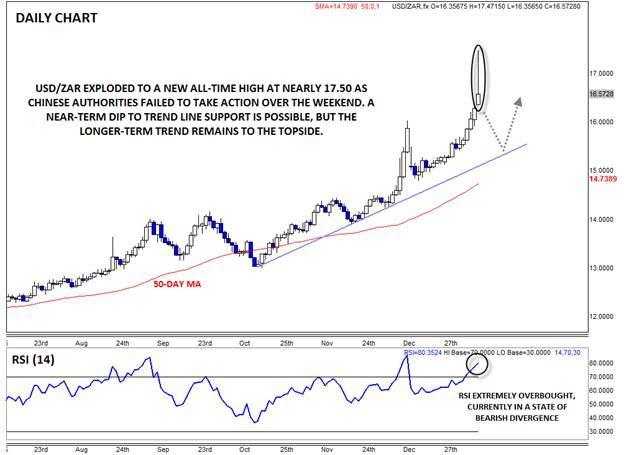![]()
With Tokyo markets offline for a bank holiday (happy Coming-of-Age Day to our Japanese readers!) following the late day collapse in US equities to close last week, traders had reason to expect that we could see some volatile price action to start this week’s trade. When Chinese authorities failed to cut the country’s Reserve Requirement Ratio (RRR), as some traders had been expecting, and actually set the value of the yuan slightly higher, it dropped a firecracker into the powder keg, leading to bizarre price action across all markets.
Chinese stocks finished the day down over 5%, but the fear did not carry over into European trade, where stocks are staging a much-needed oversold bounce. Meanwhile USD/JPY, the quintessential measure of risk appetite in today’s markets, dropped all the way down to 116.60 before reversing violently to trade back near 118.00 as of writing.
By far the biggest moves in today’s low liquidity Asian session trade were in emerging market (EM) currencies, specifically in Africa. While not too many traders are focused on the Angolan kwanza or Zambian kwacha, both of which saw big negative moves, the South African rand is one of the top 20 currencies by total volume and saw perhaps the most shocking move.
South Africa’s economy is heavily dependent on exporting minerals and metals to China, and rand traders reacted (some would say overreacted) to this fact by driving the rand down a staggering 10% against the US dollar, pushing USD/ZAR to a fresh record high at nearly 17.50. Since China first devalued the yuan back in August, South Africa’s currency has fallen by a jaw-dropping 25% against the US dollar.
Traders have since calmed down somewhat, and USD/ZAR has settled back toward 16.60, but trade is still extraordinarily volatile and risks in the pair remain elevated. The next big economic report for EM FX traders to watch will be Wednesday’s Chinese Trade Balance figures, which are expected to show declines in both exports and imports in the world’s second-largest economy.
On a technical basis, there is a chance USD/ZAR may have just seen its blowoff top. The pair is currently showing a large Bearish Pin Candle* in progress on the daily chart, showing a big intraday shift from buying to selling pressure. Meanwhile, the RSI indicator is extremely overbought and in a state of bearish divergence relative to the mid-December high.
As long as USD/ZAR holds below today’s panic high near 17.50, a dip back toward more sustainable trend line support in the mid-15.00s will be favored. That said, the economic data for both China and South Africa shows no signs of imminently turning positive, so longer-term traders may want to consider fading any near-term dips as the major trend in USD/ZAR remains to the topside for now.
*A Bearish Pin (Pinnochio) candle, or inverted hammer, is formed when prices rally within the candle before sellers step in and push prices back down to close near the open. It suggests the potential for a bearish continuation if the low of the candle is broken.
This research is for informational purposes and should not be construed as personal advice. Trading any financial market involves risk. Trading on leverage involves risk of losses greater than deposits.
Recommended Content
Editors’ Picks
AUD/USD jumps above 0.6500 after hot Australian CPI data

AUD/USD extended gains and recaptured 0.6500 in Asian trading, following the release of hotter-than-expected Australian inflation data. The Australian CPI rose 1% in QoQ in Q1 against 0.8% forecast, providing extra legs to the Australian Dollar upside.
USD/JPY hangs near 34-year high at 154.88 as intervention risks loom

USD/JPY is sitting at a multi-decade high of 154.88 reached on Tuesday. Traders refrain from placing fresh bets on the pair as Japan's FX intervention risks loom. Broad US Dollar weakness also caps the upside in the major. US Durable Goods data are next on tap.
Gold price cautious despite weaker US Dollar and falling US yields

Gold retreats modestly after failing to sustain gains despite fall in US Treasury yields, weaker US Dollar. XAU/USD struggles to capitalize following release of weaker-than-expected S&P Global PMIs, fueling speculation about potential Fed rate cuts.
Crypto community reacts as BRICS considers launching stablecoin for international trade settlement

BRICS is intensifying efforts to reduce its reliance on the US dollar after plans for its stablecoin effort surfaced online on Tuesday. Most people expect the stablecoin to be backed by gold, considering BRICS nations have been accumulating large holdings of the commodity.
US versus the Eurozone: Inflation divergence causes monetary desynchronization

Historically there is a very close correlation between changes in US Treasury yields and German Bund yields. This is relevant at the current juncture, considering that the recent hawkish twist in the tone of the Fed might continue to push US long-term interest rates higher and put upward pressure on bond yields in the Eurozone.
